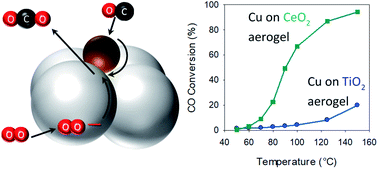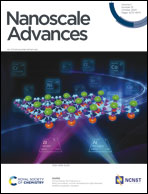Stabilization of reduced copper on ceria aerogels for CO oxidation†
Abstract
Photodeposition of Cu nanoparticles on ceria (CeO2) aerogels generates a high surface area composite material with sufficient metallic Cu to exhibit an air-stable surface plasmon resonance. We show that balancing the surface area of the aerogel support with the Cu weight loading is a critical factor in retaining stable Cu0. At higher Cu weight loadings or with a lower support surface area, Cu aggregation is observed by scanning and transmission electron microscopy. Analysis of Cu/CeO2 using X-ray photoelectron spectroscopy and Fourier-transform infrared spectroscopy finds a mixture of Cu2+, Cu+, and Cu0, with Cu+ at the surface. At 5 wt% Cu, Cu/CeO2 aerogels exhibit high activity for heterogeneous CO oxidation catalysis at low temperatures (94% conversion of CO at 150 °C), substantially out-performing Cu/TiO2 aerogel catalysts featuring the same weight loading of Cu on TiO2 (20% conversion of CO at 150 °C). The present study demonstrates an extension of our previous concept of stabilizing catalytic Cu nanoparticles in low oxidation states on reducing, high surface area aerogel supports. Changing the reducing power of the support modulates the catalytic activity of mixed-valent Cu nanoparticles and metal oxide support.

- This article is part of the themed collection: International Open Access Week 2020


 Please wait while we load your content...
Please wait while we load your content...